从Client应用场景介绍IdentityServer4(一)
原文:从Client应用场景介绍IdentityServer4(一)
一、背景
IdentityServer4的介绍将不再叙述,百度下可以找到,且官网的快速入门例子也有翻译的版本。这里主要从Client应用场景方面介绍对IdentityServer4的应用。
首先简要介绍ID Token和Access Token:
Access Token是授权第三方客户端访问受保护资源的令牌。 ID Token是第三方客户端标识用户身份认证的问令牌,是JSON Web Token格式。
二、Client应用场景介绍
Client类是为OpenID Connect或OAuth 2.0 协议建模的。
我们先看官网快速入门中给的Client例子
public static IEnumerable<Client> GetClients()
{
// client credentials client
return new List<Client>
{
new Client
{
ClientId = "Client",
AllowedGrantTypes = GrantTypes.ClientCredentials,
ClientSecrets =
{
new Secret("secret".Sha256())
},
AllowedScopes = { "api1" }
}, // resource owner password grant client
new Client
{
ClientId = "ro.client",
AllowedGrantTypes = GrantTypes.ResourceOwnerPassword, ClientSecrets =
{
new Secret("secret".Sha256())
},
AllowedScopes = { "api1" } }, // OpenID Connect hybrid flow and client credentials client (MVC)
new Client
{
ClientId = "mvc",
ClientName = "MVC Client",
AllowedGrantTypes = GrantTypes.HybridAndClientCredentials, ClientSecrets =
{
new Secret("secret".Sha256())
}, RedirectUris = { "http://localhost:5002/signin-oidc" },
PostLogoutRedirectUris = { "http://localhost:5002/signout-callback-oidc" }, AllowedScopes =
{
IdentityServerConstants.StandardScopes.OpenId,
IdentityServerConstants.StandardScopes.Profile,
"api1"
},
AllowOfflineAccess = true
}, // JavaScript Client
new Client
{
ClientId = "js",
ClientName = "JavaScript Client",
AllowedGrantTypes = GrantTypes.Implicit,
AllowAccessTokensViaBrowser = true, RedirectUris = { "http://localhost:5003/callback.html" },
PostLogoutRedirectUris = { "http://localhost:5003/index.html" },
AllowedCorsOrigins = { "http://localhost:5003" }, AllowedScopes =
{
IdentityServerConstants.StandardScopes.OpenId,
IdentityServerConstants.StandardScopes.Profile,
"api1"
},
}
};
}
里面主要介绍四种Client应用场景。
(1)客户端模式(AllowedGrantTypes = GrantTypes.ClientCredentials)
这是一种最简单的授权方式,应用于服务于服务之间的通信,token通常代表的是客户端的请求,而不是用户。
使用这种授权类型,会向token endpoint发送token请求,并获得代表客户机的access token。客户端通常必须使用token endpoint的Client ID和secret进行身份验证。
适用场景:用于和用户无关,服务与服务之间直接交互访问资源
(2)密码模式(ClientAllowedGrantTypes = GrantTypes.ResourceOwnerPassword)
该方式发送用户名和密码到token endpoint,向资源服务器请求令牌。这是一种“非交互式”授权方法。
官网上称,为了解决一些历史遗留的应用场景,所以保留了这种授权方式,但不建议使用。
适用场景:用于当前的APP是专门为服务端设计的情况。
(3)混合模式和客户端模式(ClientAllowedGrantTypes =GrantTypes.HybridAndClientCredentials)
ClientCredentials授权方式在第一种应用场景已经介绍了,这里主要介绍Hybrid授权方式。Hybrid是由Implicit和Authorization code结合起来的一种授权方式。其中Implicit用于身份认证,ID token被传输到浏览器并在浏览器进行验证;而Authorization code使用反向通道检索token和刷新token。
推荐适用Hybrid模式。
适用场景:用于MVC框架,服务器端 Web 应用程序和原生桌面/移动应用程序。
(4)简化模式(ClientAllowedGrantTypes =GrantTypes.Implicit)
Implicit要么仅用于服务端和JavaScript应用程序端进行身份认证,要么用于身份身份验证和access token的传输。
在Implicit中,所有token都通过浏览器传输的。
适用场景:JavaScript应用程序。
三、Server端搭建
为了介绍IdentityServer4的Client应用场景,我们需要先搭建IdentityServer服务端。
这里搭建的是使用EF Core来做数据操作,保存到SQL Server中。
(1)新建API项目
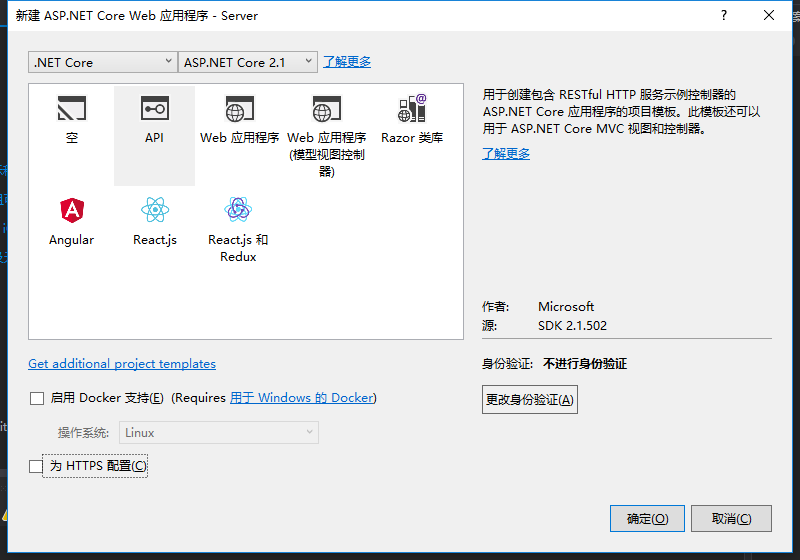
(2)安装IdentityServer4.EntityFramework包

(3)安装IdentityServer4包
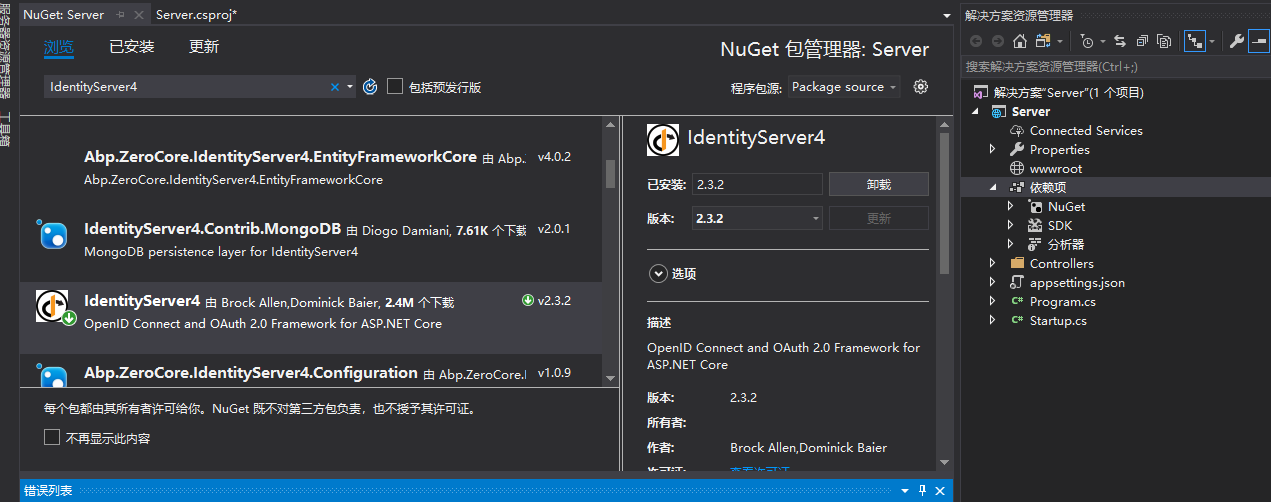
(4)右键项目的属性,编辑项目的.csproj文件
添加如下元素
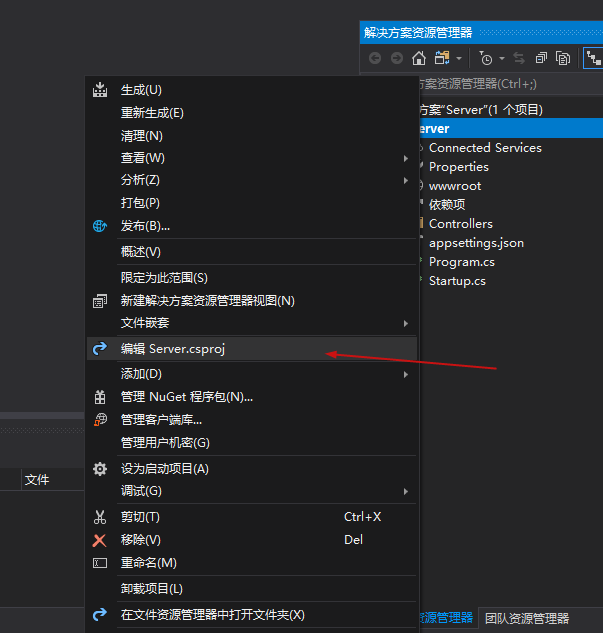
<ItemGroup>
<DotNetCliToolReference Include="Microsoft.EntityFrameworkCore.Tools.DotNet" Version="2.0.0" />
</ItemGroup>
如图:

(5)cmd管理员身份进入项目目录路径(D:\IdentityServer4\Server),运行:dotnet ef
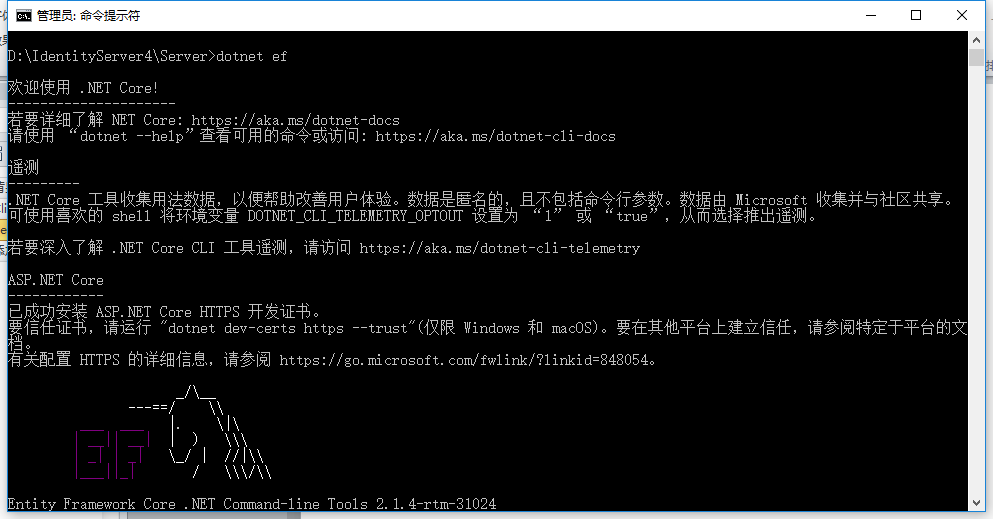
(6)项目内添加Config.cs类,代码如下
public class Config
{
public static List<TestUser> GetUsers()
{
return new List<TestUser>
{
new TestUser
{
SubjectId = "1",
Username = "alice",
Password = "password", Claims = new List<Claim>(){new Claim(JwtClaimTypes.Role,"superadmin") }
},
new TestUser
{
SubjectId = "2",
Username = "bob",
Password = "password", Claims = new List<Claim>
{
new Claim("name", "Bob"),
new Claim("website", "https://bob.com")
},
}
};
} public static IEnumerable<Client> GetClients()
{
// client credentials client
return new List<Client>
{
new Client
{
ClientId = "Client",
AllowedGrantTypes = GrantTypes.ClientCredentials,
ClientSecrets =
{
new Secret("secret".Sha256())
},
AllowedScopes = { "api1" }
}, // resource owner password grant client
new Client
{
ClientId = "ro.client",
AllowedGrantTypes = GrantTypes.ResourceOwnerPassword, ClientSecrets =
{
new Secret("secret".Sha256())
},
AllowedScopes = { "api1" }
}, // OpenID Connect hybrid flow and client credentials client (MVC)
new Client
{
ClientId = "mvc",
ClientName = "MVC Client",
AllowedGrantTypes = GrantTypes.HybridAndClientCredentials, ClientSecrets =
{
new Secret("secret".Sha256())
}, RedirectUris = { "http://localhost:5002/signin-oidc" },
PostLogoutRedirectUris = { "http://localhost:5002/signout-callback-oidc" }, AllowedScopes =
{
IdentityServerConstants.StandardScopes.OpenId,
IdentityServerConstants.StandardScopes.Profile,
"api1"
},
AllowOfflineAccess = true
}, // JavaScript Client
new Client
{
ClientId = "js",
ClientName = "JavaScript Client",
AllowedGrantTypes = GrantTypes.Implicit,
AllowAccessTokensViaBrowser = true, RedirectUris = { "http://localhost:5003/callback.html" },
PostLogoutRedirectUris = { "http://localhost:5003/index.html" },
AllowedCorsOrigins = { "http://localhost:5003" }, AllowedScopes =
{
IdentityServerConstants.StandardScopes.OpenId,
IdentityServerConstants.StandardScopes.Profile,
"api1"
},
}
};
}
public static IEnumerable<IdentityResource> GetIdentityResources()
{
return new List<IdentityResource>
{
new IdentityResources.OpenId(),
new IdentityResources.Profile(),
};
} public static IEnumerable<ApiResource> GetApiResources()
{
return new List<ApiResource>
{
new ApiResource("api1", "My API")
};
}
添加引用:
using IdentityModel;
using IdentityServer4;
using IdentityServer4.Models;
using IdentityServer4.Test;
using System.Collections.Generic;
using System.Security.Claims;
(7)编辑Startup.cs文件的ConfigureServices方法,改成如下代码。
public void ConfigureServices(IServiceCollection services)
{
const string connectionString = @"Server=localhost;database=IdentityServer4;User ID=sa;Password=Pwd;trusted_connection=yes";
var migrationsAssembly = typeof(Startup).GetTypeInfo().Assembly.GetName().Name; // configure identity server with in-memory stores, keys, clients and scopes
services.AddIdentityServer()
.AddDeveloperSigningCredential()
.AddTestUsers(Config.GetUsers())
// this adds the config data from DB (clients, resources)
.AddConfigurationStore(options =>
{
options.ConfigureDbContext = builder =>
builder.UseSqlServer(connectionString,
sql => sql.MigrationsAssembly(migrationsAssembly));
})
// this adds the operational data from DB (codes, tokens, consents)
.AddOperationalStore(options =>
{
options.ConfigureDbContext = builder =>
builder.UseSqlServer(connectionString,
sql => sql.MigrationsAssembly(migrationsAssembly)); // this enables automatic token cleanup. this is optional.
options.EnableTokenCleanup = false;//是否从数据库清楚令牌数据,默认为false
options.TokenCleanupInterval = 300;//令牌过期时间,默认为3600秒,一个小时
});
//.AddInMemoryClients(Config.GetClients());
services.AddMvc().SetCompatibilityVersion(CompatibilityVersion.Version_2_1);
}
添加引用:
using Microsoft.EntityFrameworkCore;
using System.Reflection;
(8)cmd管理员身份进入到项目目录路径(D:\IdentityServer4\Server\Server),注意,多了一层目录,分别运行以下两条指令:
dotnet ef migrations add InitialIdentityServerPersistedGrantDbMigration -c PersistedGrantDbContext -o Data/Migrations/IdentityServer/PersistedGrantDb dotnet ef migrations add InitialIdentityServerConfigurationDbMigration -c ConfigurationDbContext -o Data/Migrations/IdentityServer/ConfigurationDb

运行完后,项目中会多了一个Data文件夹
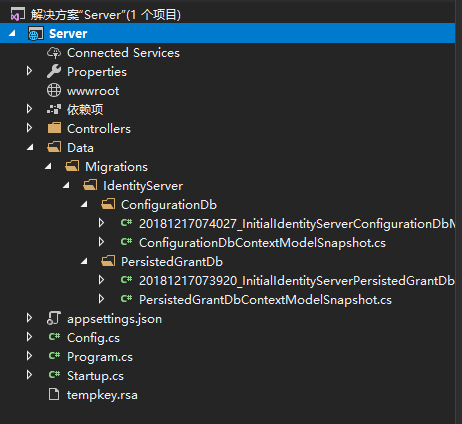
(9)在Startup.cs中添加初始化数据库方法。
private void InitializeDatabase(IApplicationBuilder app)
{
using (var serviceScope = app.ApplicationServices.GetService<IServiceScopeFactory>().CreateScope())
{
serviceScope.ServiceProvider.GetRequiredService<PersistedGrantDbContext>().Database.Migrate(); var context = serviceScope.ServiceProvider.GetRequiredService<ConfigurationDbContext>();
context.Database.Migrate();
if (!context.Clients.Any())
{
foreach (var client in Config.GetClients())
{
context.Clients.Add(client.ToEntity());
}
context.SaveChanges();
} if (!context.IdentityResources.Any())
{
foreach (var resource in Config.GetIdentityResources())
{
context.IdentityResources.Add(resource.ToEntity());
}
context.SaveChanges();
} if (!context.ApiResources.Any())
{
foreach (var resource in Config.GetApiResources())
{
context.ApiResources.Add(resource.ToEntity());
}
context.SaveChanges();
}
}
}
添加引用:
using IdentityServer4.EntityFramework.DbContexts;
using IdentityServer4.EntityFramework.Mappers;
(10)在Startup.cs中的Configure方法修改成以下代码。
public void Configure(IApplicationBuilder app, IHostingEnvironment env)
{
//if (env.IsDevelopment())
//{
// app.UseDeveloperExceptionPage();
//}
InitializeDatabase(app);
//app.UseMvc();
}
到这里,把项目以控制台形式运行
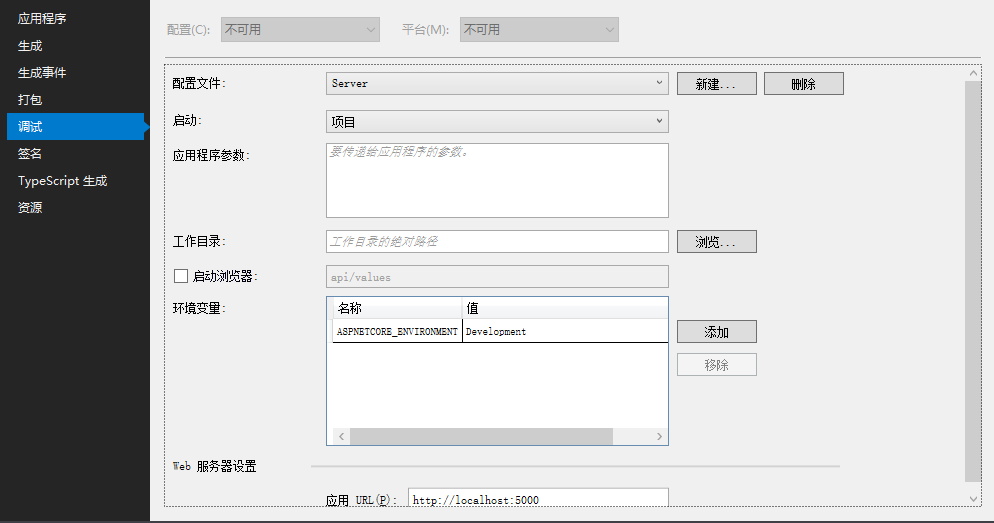

点击运行,可以跑起来,且生成数据库IdentityServer4DB。
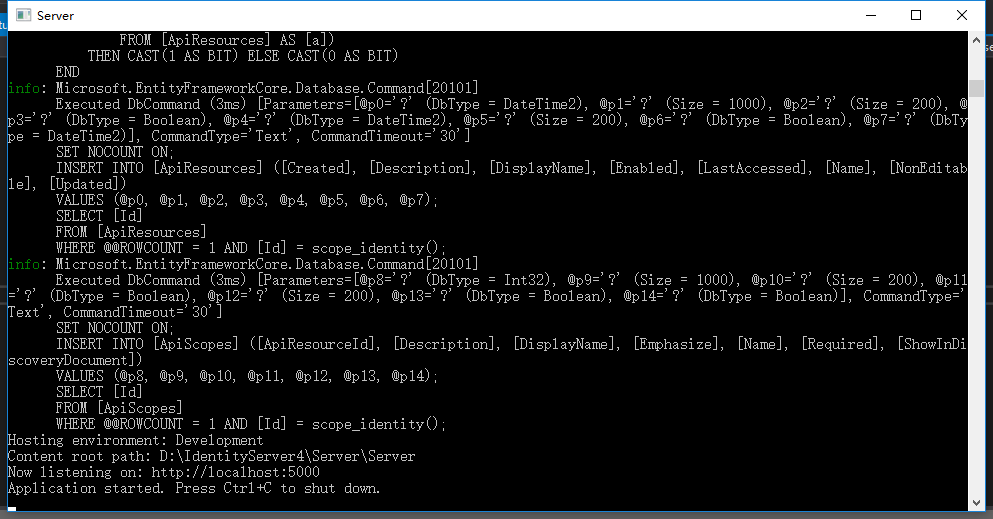

关于Client的说明可以查阅官网资料:https://identityserver4.readthedocs.io/en/release/reference/client.html
源码地址:https://github.com/Bingjian-Zhu/Server.git
服务端准备好之后,下篇文章开始介绍Client客户端的应用。
文中如有错漏,欢迎指正,将对此系列文章进行维护。
从Client应用场景介绍IdentityServer4(一)的更多相关文章
- 从Client应用场景介绍IdentityServer4(五)
原文:从Client应用场景介绍IdentityServer4(五) 本节将在第四节基础上介绍如何实现IdentityServer4从数据库获取User进行验证,并对Claim进行权限设置. 一.新建 ...
- 从Client应用场景介绍IdentityServer4(四)
原文:从Client应用场景介绍IdentityServer4(四) 上节以对话形式,大概说了几种客户端授权模式的原理,这节重点介绍Hybrid模式在MVC下的使用.且为实现IdentityServe ...
- 从Client应用场景介绍IdentityServer4(三)
原文:从Client应用场景介绍IdentityServer4(三) 在学习其他应用场景前,需要了解几个客户端的授权模式.首先了解下本节使用的几个名词 Resource Owner:资源拥有者,文中称 ...
- 从Client应用场景介绍IdentityServer4(二)
原文:从Client应用场景介绍IdentityServer4(二) 本节介绍Client的ClientCredentials客户端模式,先看下画的草图: 一.在Server上添加动态新增Client ...
- 消息中间件activemq的使用场景介绍(结合springboot的示例)
一.消息队列概述 消息队列中间件是分布式系统中重要的组件,主要解决应用耦合,异步消息,流量削锋等问题.实现高性能,高可用,可伸缩和最终一致性架构.是大型分布式系统不可缺少的中间件. 目前在生产环境,使 ...
- Redis 中 5 种数据结构的使用场景介绍
这篇文章主要介绍了Redis中5种数据结构的使用场景介绍,本文对Redis中的5种数据类型String.Hash.List.Set.Sorted Set做了讲解,需要的朋友可以参考下 一.redis ...
- Memcache应用场景介绍
面临的问题 对于高并发高訪问的Web应用程序来说,数据库存取瓶颈一直是个令人头疼的问题.特别当你的程序架构还是建立在单数据库模式,而一个数据池连接数峰 值已经达到500的时候,那你的程序执行离崩溃的边 ...
- SharePoint Server 2013开发之旅(一):新的开发平台和典型开发场景介绍
我终于开始写这个系列文章,实际上确实有一段时间没有动笔了.最近重新安装了一套SharePoint Server 2013的环境,计划利用工作之余的时间为大家写一点新的东西. SharePoint Se ...
- ZooKeeper应用场景介绍
ZooKeeper是一个高可用的分布式数据管理与系统协调框架.维护着一个树形层次结构,书中的节点被称为znode.znode可以用来存储数据,并且有一个与之相关联的ACL(权限),znode不能大于1 ...
随机推荐
- 巴什博奕小结 HDU2188 HDU1846 HDU2149
摘自百度百科: 巴什博奕(Bash Game):只有一堆n个物品,两个人轮流从这堆物品中取物,规定每次至少取一个,最多取m个.最后取光者得胜. 显然,如果n=m+1,那么由于一次最多只能取m个,所以, ...
- Vue.js组件的重要选项
Vue.js组件的重要选项 实例化Vue对象一些很重要的选项,Vue的所有数据都是放在data里面的,Vue的参数是个对象,对象里面的字段叫做data,data里面也是对象,data也可以写作是thi ...
- MySQL—Install/Remove of the Service Denied
在Windos7下通过命令"mysqld --install"安装MySQL数据库时出现了"Install/Remove of the Service Denied&qu ...
- Java反射学习总结二(用反射调用对象的私有属性和方法)
大家都知道正常的调用是不可以访问对象的private修饰的属性和方法的,这也是Java的封装性原则. 但是有没有方法可以强制去访问对象的private修饰的属性和方法呢?那就是用反射!(这个可能在面试 ...
- HDU 1425 sort hash+加速输入
http://acm.hdu.edu.cn/showproblem.php?pid=1425 题目大意: 给你n个整数,请按从大到小的顺序输出其中前m大的数. 其中n和m都是位于[-500000,50 ...
- POJ 1458 Common Subsequence (zoj 1733 ) LCS
POJ:http://poj.org/problem?id=1458 ZOJ:http://acm.zju.edu.cn/onlinejudge/showProblem.do?problemId=73 ...
- 基于Android Fragment功能的样例
通过近期空暇时候对Fragment的学习,尝试着写了一个小Demo,将在开发的时候能经常使用到的Fragment知识放在一起,写过了这个Demo对Android Fragment的了解更加深入了,以后 ...
- 读取Webpage表中的内容 分类: H3_NUTCH 2015-02-10 14:59 418人阅读 评论(0) 收藏
nutch将从网页中抓取到的信息放入hbase数据库中,默认情况下表名为$crawlId_webpage,但表中的内容以16进制进行表示,直接scan或者通过Java API进行读取均只能读取到16进 ...
- synology
入手群晖261J无法正常安装DSM 错误代码38 求教各位恶魔https://www.chiphell.com/thread-1599081-1-1.html(出处: Chiphell - 分享与交流 ...
- 文件上传api——MultipartFile
MultipartFile 方法总结 byte[] getBytes() 返回文件的内容作为一个字节数组. String getContentType() 返回文件的内容类型. InputStr ...
